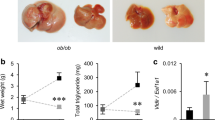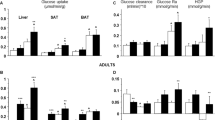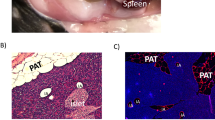Abstract
Rats vary in their propensity to become obese when eating a high-fat diet, but the factors that make some rats susceptible and others resistant to diet-induced obesity are unclear. Recent studies show that rats predisposed to diet-induced obesity have a preexisting deficit in fat oxidation and suggest that this impairment is due in part to reduced fatty acid oxidation in liver. To determine directly whether rats susceptible to diet-induced obesity are less able to oxidize fatty acids in liver, we measured palmitate oxidation in hepatocytes isolated from outbred Sprague–Dawley rats that were identified while still eating a low-fat diet as obesity-prone or obesity-resistant by using a new screening procedure based on the change in plasma triglyceride concentration produced by an intragastric load of a fat and carbohydrate mixture. The results showed that hepatocytes from rats thus identified as obesity-prone oxidized 44% less palmitate in vitro than did those from obesity-resistant rats. This difference in hepatocyte fatty acid oxidation is consistent with and may explain at least in part the reduced capacity of obesity-prone rats to oxidize fat.
This is a preview of subscription content, access via your institution
Access options
Subscribe to this journal
Receive 12 print issues and online access
$259.00 per year
only $21.58 per issue
Buy this article
- Purchase on Springer Link
- Instant access to full article PDF
Prices may be subject to local taxes which are calculated during checkout


Similar content being viewed by others
References
Schemmel R, Mickelsen O, Gill JL . Dietary obesity in rats: body weight and body fat accretion in seven strains of rats. J Nutr 1970; 100: 1041–1048.
West DB, Boozer CN, Moody DL, Atkinson RL . Dietary obesity in nine inbred mouse strains. Am J Physiol 1992; 262: R1025–R1032.
Levin BE, Sullivan AC . Glucose-induced norepinephrine levels and obesity resistance. Am J Physiol 1987; 253: R475–R481.
Levin BE, Dunn-Meynell AA, Balkan B, Keesey RE . Selective breeding for diet-induced obesity and resistance in Sprague–Dawley rats. Am J Physiol 1997; 273: R725–R730.
Ji H, Friedman MI . Fasting plasma triglyceride levels and fat oxidation predict dietary obesity in rats. Physiol Behav 2003; 78: 767–772.
Ji H, Outterbridge LV, Friedman MI . Phenotype-based treatment for dietary obesity: differential effects of fenofibrate in obesity-prone and obesity-resistant rats. Metabolism 2005; 54: 421–429.
Ji H, Friedman MI . Reduced capacity for fatty acid oxidation in rats with inherited susceptibility to diet-induced obesity. Metabolism 2007; 56: 1124–1130.
Levin BE . Sympathetic activity, age, sucrose preference, and diet-induced obesity. Obes Res 1993; 1: 281–287.
Edens NK, Friedman MI . Satiating effect of fat in diabetic rats: gastrointestinal and postabsorptive factors. Am J Physiol 1988; 255: R123–R127.
Ji H, Graczyk-Milbrandt G, Osbakken MD, Friedman MI . Interactions of dietary fat and 2,5-anhydro-D-mannitol on energy metabolism in isolated rat hepatocytes. Am J Physiol 2002; 282: R715–R720.
Jackman MR, Kramer RE, MacLean PS, Bessesen DH . Trafficking of dietary fat in obesity-prone and obesity-resistant rats. Am J Physiol 2006; 291: E1083–E1091.
Friedman MI, Harris RB, Ji H, Ramirez I, Tordoff MG . Fatty acid oxidation affects food intake by altering hepatic energy status. Am J Physiol 1999; 276: R1046–R1053.
Langhans W, Scharrer E . Evidence for a vagally mediated satiety signal derived from hepatic fatty acid oxidation. J Auton Nerv Syst 1987; 18: 13–18.
Acknowledgements
This work was supported by NIH grant DK-53109. We thank Ms Lisa Outterbridge for her assistance with the experiments and Dr Michael Tordoff and Dr Danielle Reed for their comments on an earlier draft of the paper.
Author information
Authors and Affiliations
Corresponding author
Rights and permissions
About this article
Cite this article
Ji, H., Friedman, M. Reduced hepatocyte fatty acid oxidation in outbred rats prescreened for susceptibility to diet-induced obesity. Int J Obes 32, 1331–1334 (2008). https://doi.org/10.1038/ijo.2008.71
Received:
Revised:
Accepted:
Published:
Issue Date:
DOI: https://doi.org/10.1038/ijo.2008.71



